If there’s one brand that has kept everyone talking (and walking comfortably) in recent years, it’s Birkenstock.
But what is it about these iconic sandals that have people completely hooked? Famous for its signature contoured footbed, the brand perfectly balances tradition and modern style. That’s exactly why we’ve chosen to write this Birkenstock branding strategy – it’s a brand that’s stayed true to its roots while evolving with the times.
In this breakdown, we’ll dive into the strategies that have kept Birkenstock relevant and made it a leader in functional footwear and cultural influence.
About Birkenstock

Birkenstock, founded in 1774 by John Adam Birkenstock in Germany, started as an insole manufacturer before expanding into footwear.
In 1963, Karl Birkenstock revolutionized the brand by introducing the Madrid sandal, featuring a cork footbed designed for comfort and support. This innovation marked a turning point, establishing Birkenstock as a global leader in orthopedic footwear.
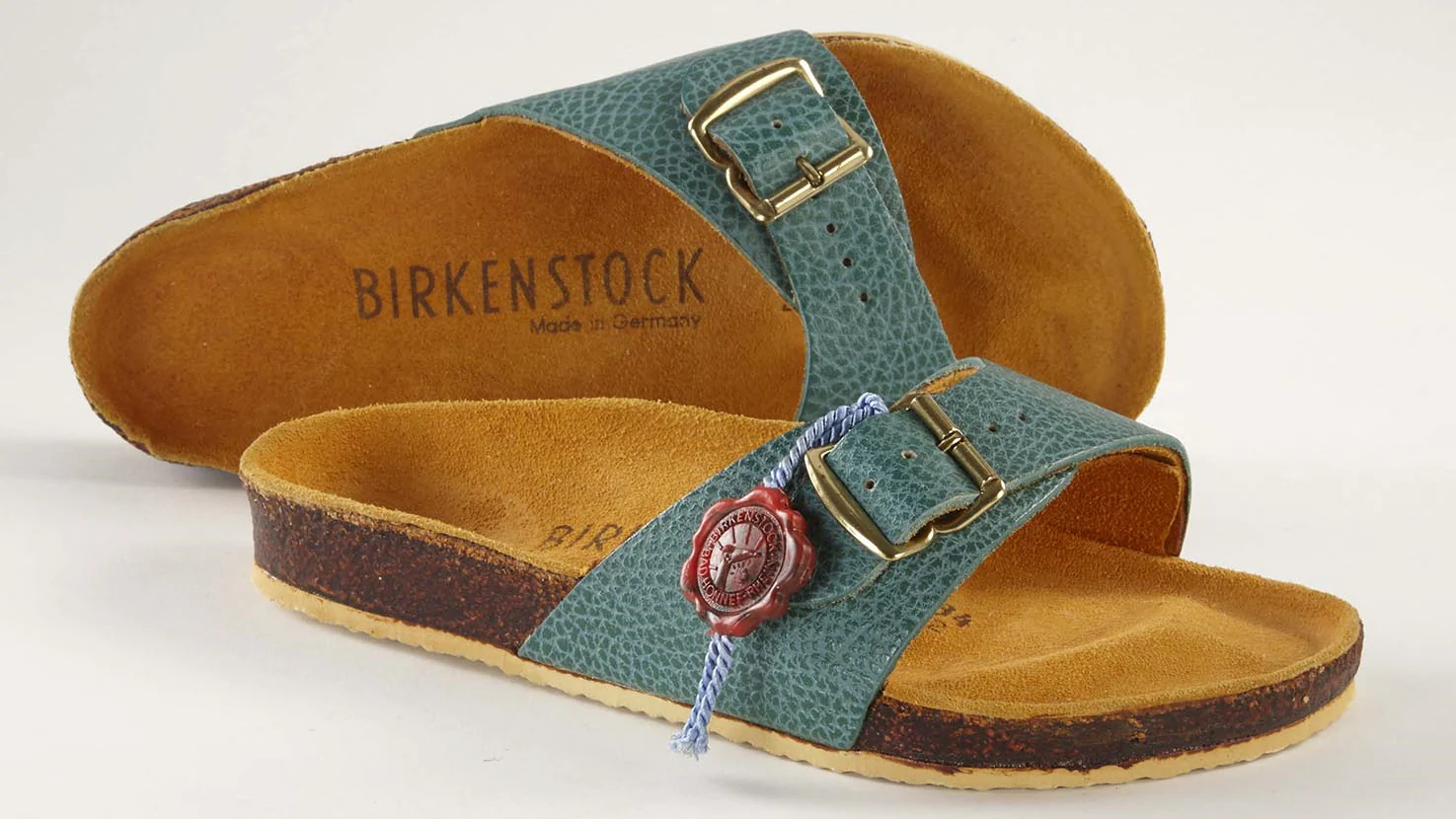
Source: Birkenstock
Today, the brand appeals to a wide audience—health-conscious individuals to fashion-forward consumers—by combining comfort with style. In fiscal 2024, Birkenstock reported EUR 1.8 billion in revenue, a 22% increase over fiscal 2023, continuing its decade-long streak of 20%+ annual growth.
So, is it just comfort and style driving Birkenstock’s success? Not quite. There’s more to the brand’s strategy, which we’ll explore in the next sections.
Birkenstock branding strategy details
What makes Birkenstock so special? Let’s break down the key elements of Bikenstock branding strategy over the years.
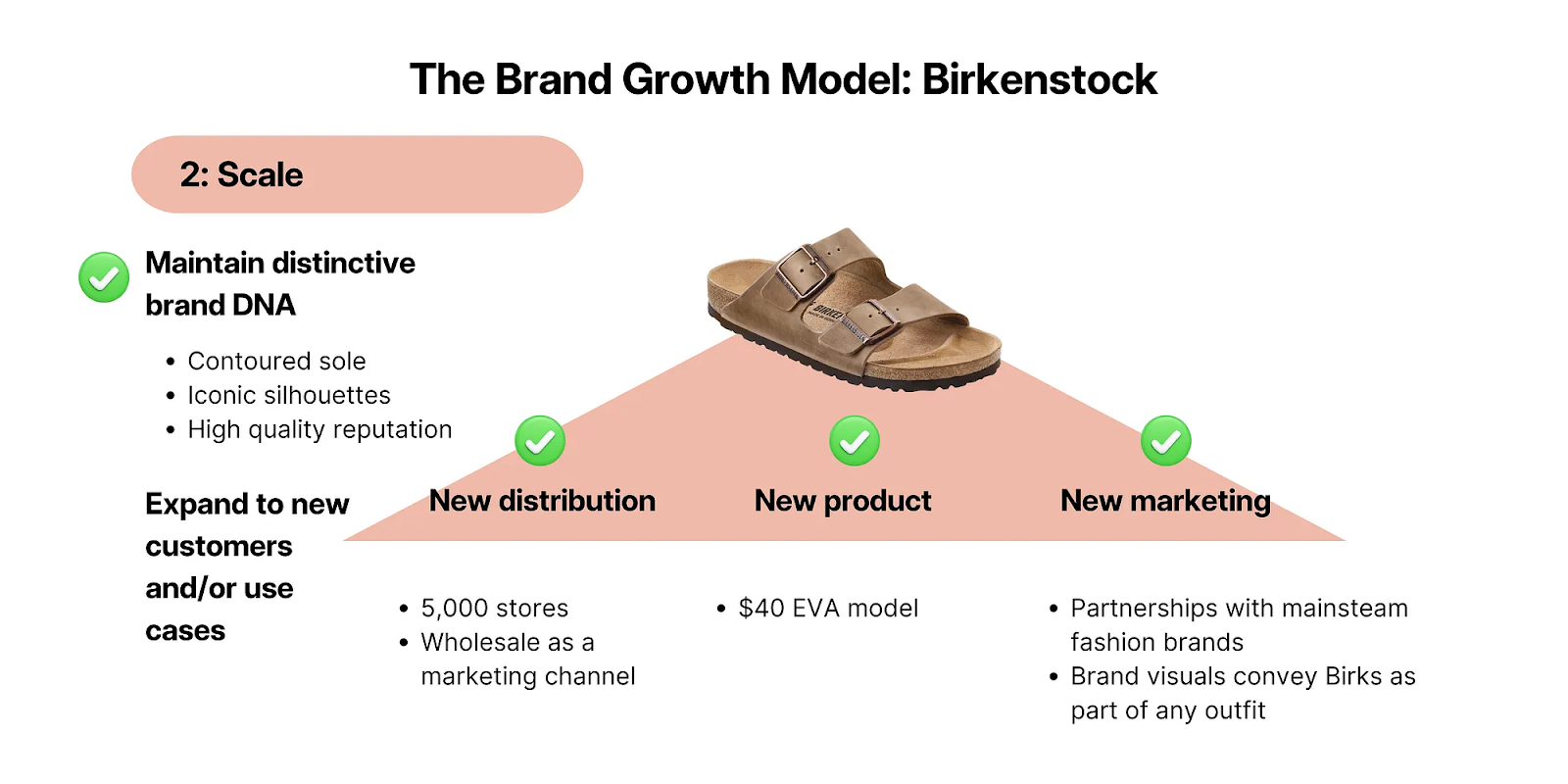
1. Brand Identity
Birkenstock has created a unique identity by focusing on comfort, quality, and sustainability. Here’s how they’ve made it happen:
Logo and visuals
The Birkenstock logo is simple yet bold, with clean lettering that gives a sense of reliability. The earthy colors, like browns and greens, show the brand’s connection to nature and its eco-friendly values. Its minimalistic visuals emphasize simplicity and durability, making Birkenstock’s style instantly recognizable.
Tagline and messaging
Birkenstock’s message is all about comfort, health, and sustainability. They use a clear and honest tone, focusing on the real benefits of their footwear. Instead of flashy ads, they highlight functionality and authenticity, which appeal to people who care about quality and practicality.
Brand personality
Birkenstock is dependable, approachable, and eco-conscious. It’s not a brand that tries to be flashy or trendy. Instead, it focuses on being genuine and trustworthy. Putting sustainability and practicality first connects with people who value well-being—for themselves and the planet.
2. Value proposition
Birkenstock’s commitment to sustainability is a core value and a smart marketing strategy. The brand uses natural, renewable materials like cork and latex, paired with eco-friendly practices such as heat-capturing power plants.
This approach resonates with eco-conscious consumers, fostering loyalty while attracting new customers. Every pair of Birkenstocks reflects the brand’s 240-year tradition of blending timeless design with modern functionality.
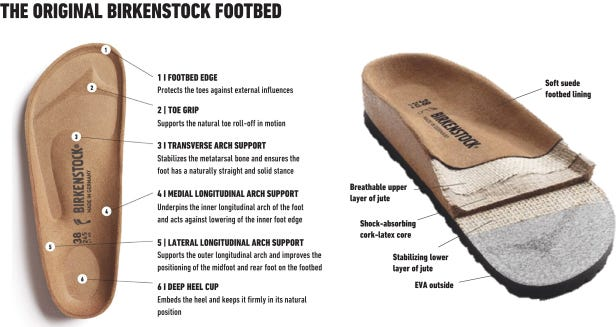
What truly sets Birkenstock apart is its groundbreaking footbed design. Created to mirror the foot’s natural contours, it offers unmatched support and comfort, ensuring that “when your feet feel good, you feel good.” This perfect mix of tradition, innovation, and dedication to quality has made Birkenstock a global icon in design and lifestyle.
3. Positioning strategy
Birkenstock’s market positioning is centered on delivering premium comfort and sustainability, with key differentiators setting it apart in a competitive landscape.
While Crocs leads with lightweight, casual, and colorful options, Birkenstock stands out with its timeless, orthopedic designs, appealing to consumers who prioritize durability and foot health.
Teva, known for its rugged, water-resistant sandals, targets outdoor enthusiasts. In contrast, Birkenstock offers versatile, everyday footwear seamlessly transitioning from casual to semi-formal settings.
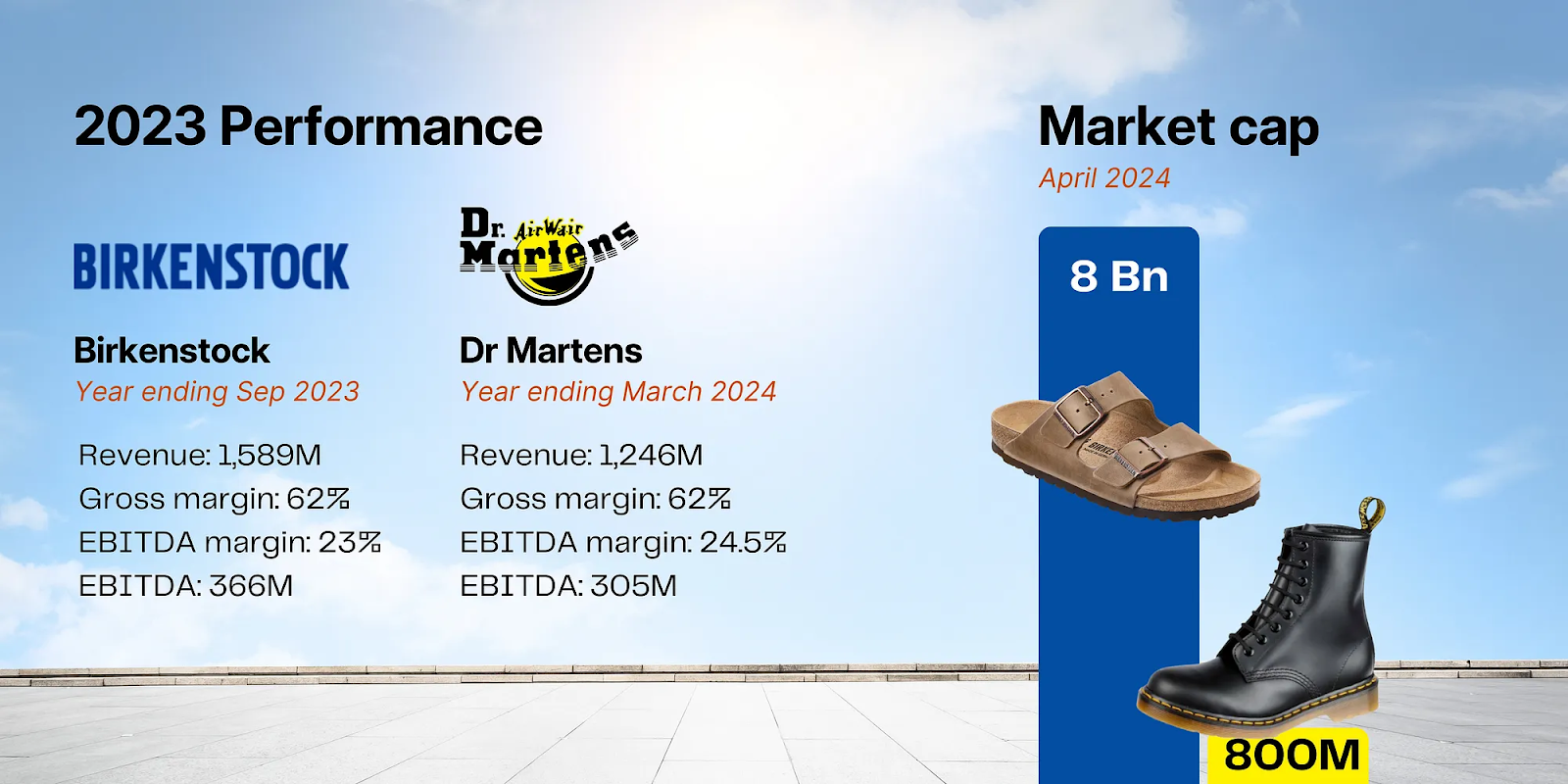
Dr. Martens, famous for its bold, rebellious look, appeals to a niche, subculture-driven audience. On the other hand, Birkenstock has a broader appeal, resonating with eco-conscious millennials, Gen Z, and professionals who value functionality.
Even luxury brands like Gucci and Hermès, which have launched sandals inspired by Birkenstock, highlight the brand’s influence in merging comfort with high-end fashion.
Birkenstock’s competitive advantage lies in its sustainable practices and heritage craftsmanship, offering lasting value beyond aesthetics. Its classic designs outlast the trend-driven focus of rivals like Crocs and Teva, ensuring lasting customer loyalty.
By striking a balance between affordability and premium pricing, Birkenstock attracts budget-conscious and luxury-seeking shoppers, making it a versatile player in the global footwear market.
4. Marketing and advertising strategy
Here’s a look at how Bikenstock built a marketing and advertising strategy that resonates with today’s consumers.
Iconic marketing campaigns
Birkenstock’s marketing campaigns often balance comfort and style, reshaping how their products are perceived. Traditionally viewed as casual or utilitarian footwear, Birkenstock has elevated its image through targeted campaigns.
“Beyond The Critics” campaign
Birkenstocks “Beyond The Critics” campaign directly confronted the negative perceptions around its products, using real critiques as taglines in campaign materials. By embracing the critiques head-on, the campaign emphasized the practical benefits of Birkenstock footwear, letting its undeniable comfort shine through.
This approach shifted the narrative from superficial aesthetic judgments to real-world functionality, showing consumers that comfort and quality far outweigh fleeting fashion trends.
High fashion collaborations

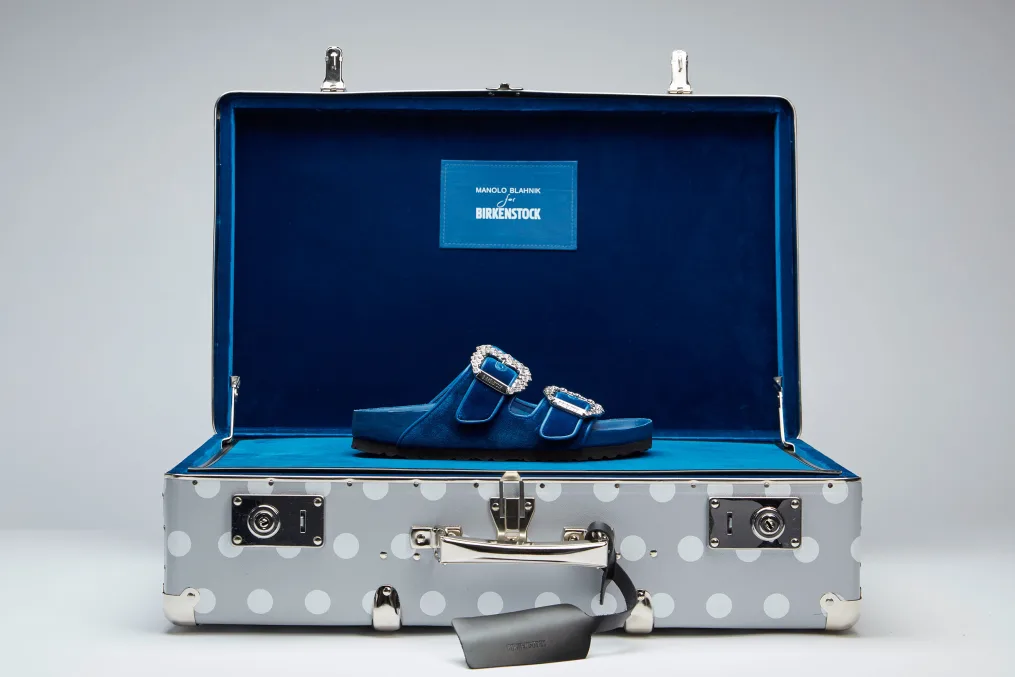
Birkenstock further reinforced its position as a premium brand by collaborating with high-fashion designers. Partnerships with Jil Sander, Manolo Blahnik, and others helped the brand reach a fashion-conscious demographic. These limited-edition releases created buzz and signaled to consumers that Birkenstock products could be both comfortable and stylish.
Leveraging the power of e-commerce
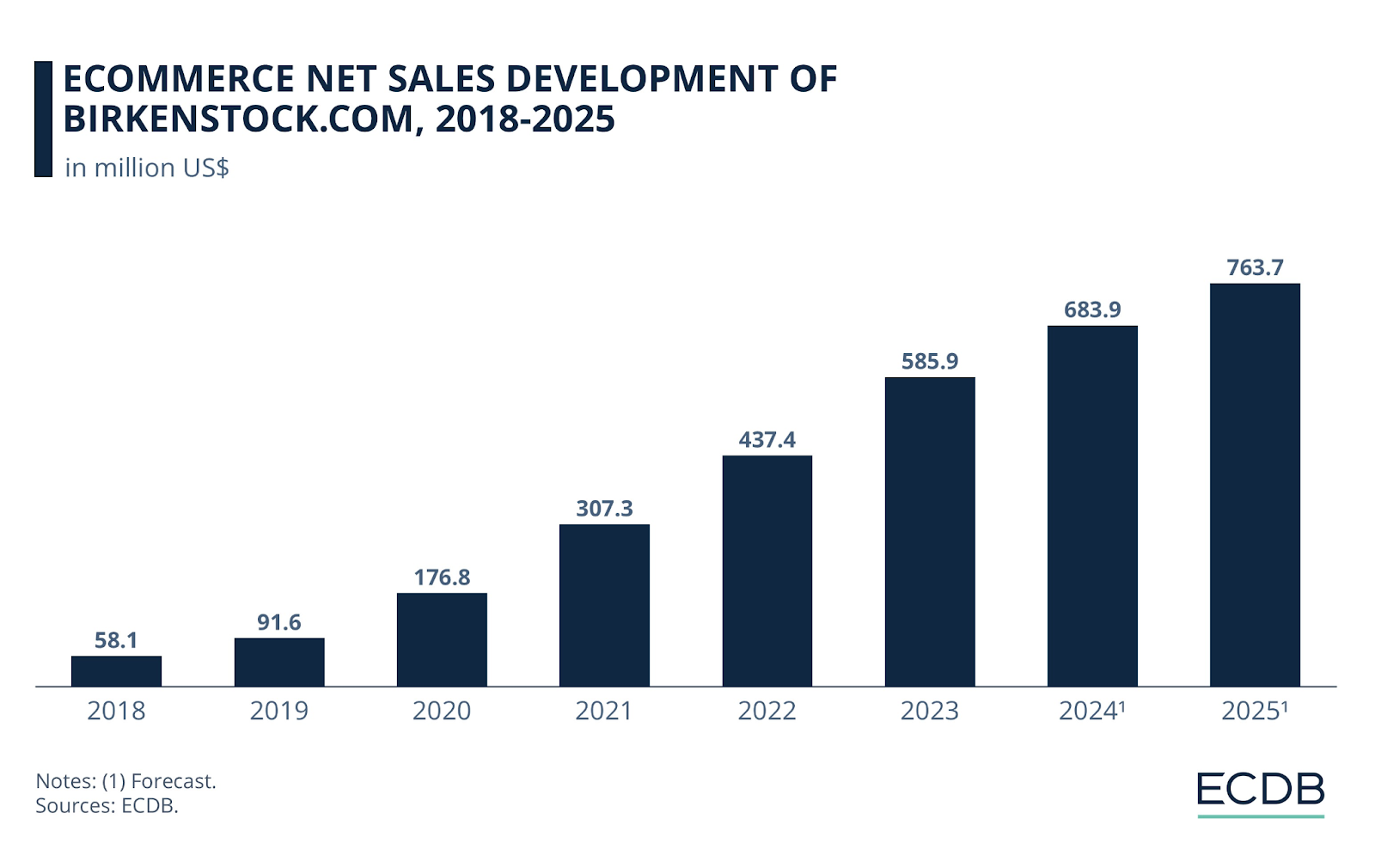
Birkenstock made a significant push toward digital platforms, allowing them to reach a broader global audience. Their online presence played a key role in the brand’s growth.
The role of Birkenstock digital GmbH
Founded in 2015, Birkenstock Digital GmbH was created to manage online marketing and sales. In 2020, this digital shift led to a 90% increase in e-commerce sales, a remarkable achievement during the pandemic.
Direct-to-Consumer (DTC) model
The DTC model gave Birkenstock control over customer experience and relationships. They created a seamless and personalized shopping experience by selling directly through their website, boosting online sales, and strengthening their brand identity.
Social media marketing
Social media is a major tool for Birkenstock, helping the brand connect with customers where they spend most of their time. The brand maintains a consistent presence across Instagram, Pinterest, and Facebook, each serving a unique purpose:

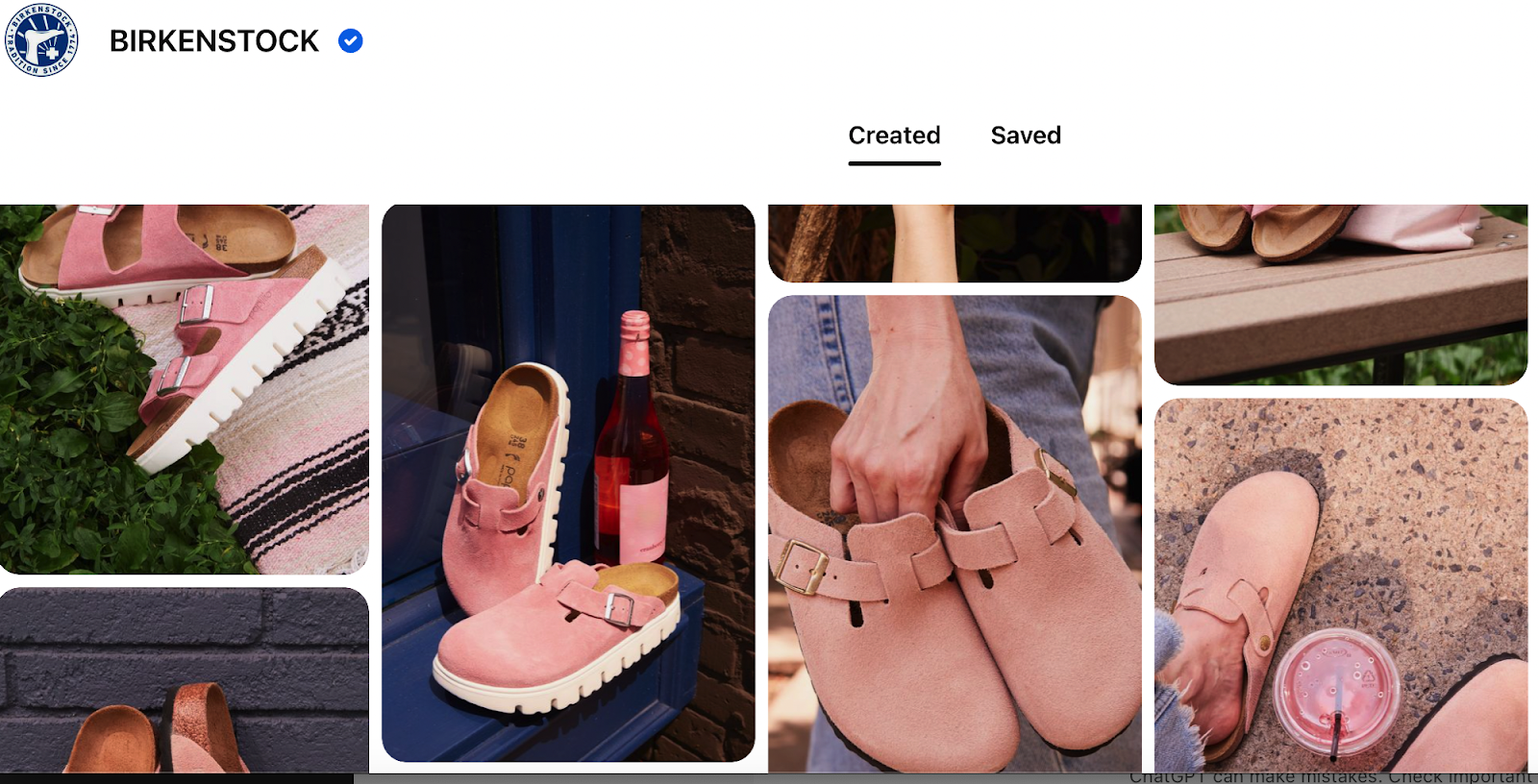
- Instagram: A platform for showcasing lifestyle imagery and influencer collaborations.
- Pinterest: A source of inspiration with curated outfit and footwear ideas.
- Facebook: Used for community-building, customer engagement, and conversations around the brand.
Birkenstock also emphasizes sustainability on social media, showcasing its eco-friendly materials and responsible manufacturing practices—appealing to environmentally-conscious consumers.
Influencer marketing
Influencer marketing is central to Birkenstock’s digital outreach. By partnering with influencers across fashion, wellness, and sustainability, the brand taps into communities that align with its values.

These partnerships aren’t limited to fashion influencers; wellness and sustainability advocates highlight Birkenstocks orthopedic features and eco-friendly qualities. This broadens the brand’s appeal, connecting with younger, more diverse audiences.
Storytelling
Birkenstock uses storytelling to create an emotional connection with consumers. By crafting compelling narratives, the brand differentiates itself from other footwear brands and deepens its customer bond.

Example: “Ugly for a reason” Campaign. This campaign positioned Birkenstock sandals as more than just footwear—they became a symbol of freedom, comfort, and a laid-back lifestyle. The messaging emphasized the brand’s versatility, showing how Birkenstock could fit into every aspect of life, from casual outings to fashionable events.
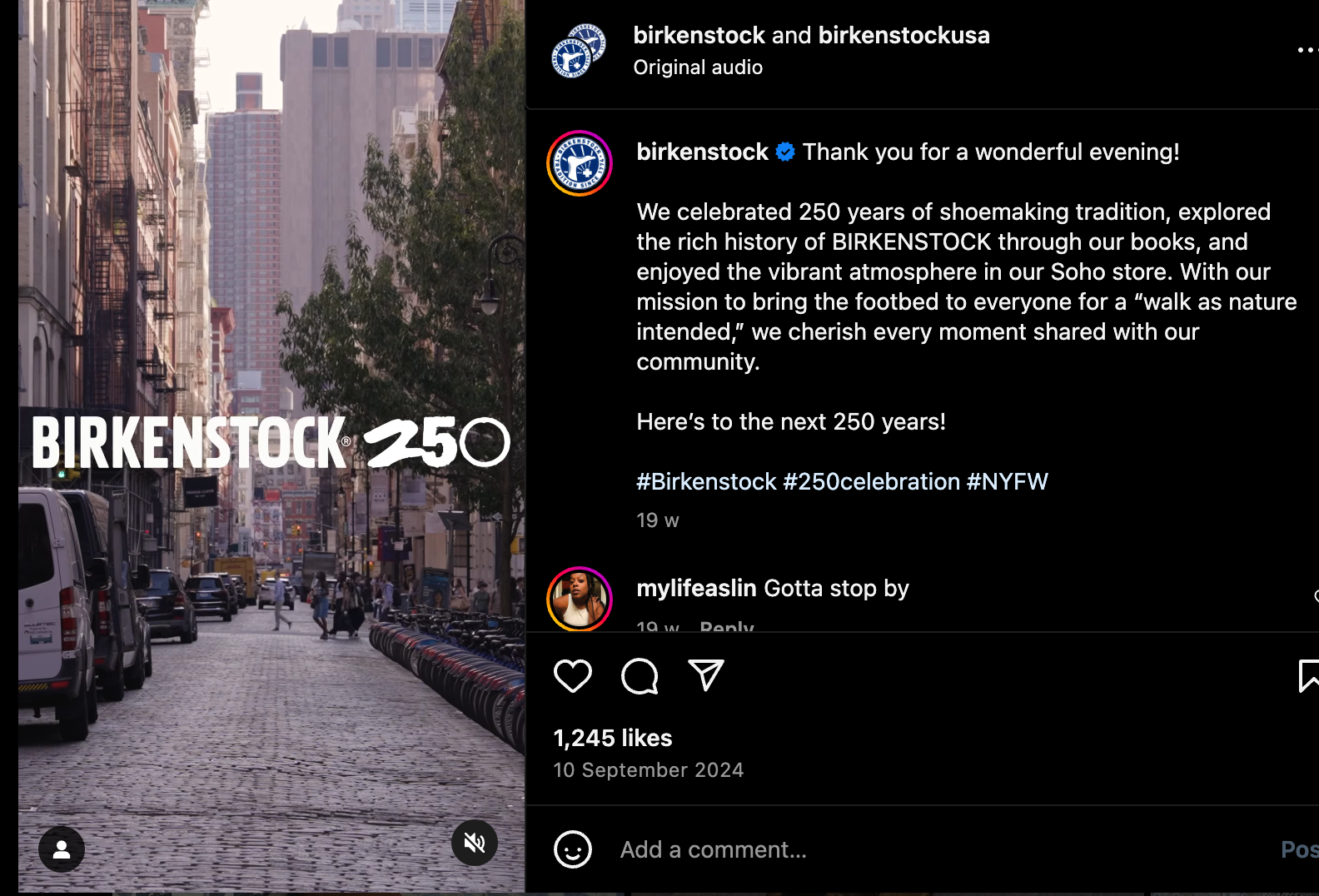
Birkenstock also leans on its rich history dating back to 1774, showcasing its craftsmanship and quality. This focus on heritage builds trust, reassuring customers that Birkenstock is a brand that has stood the test of time.
5. Customer experience and engagement
The brand understands that today’s consumers value more than just the product—they crave meaningful interactions and a sense of belonging. Birkenstock’s customer service focuses on personalized, responsive care, ensuring customers feel valued and heard at every touchpoint.

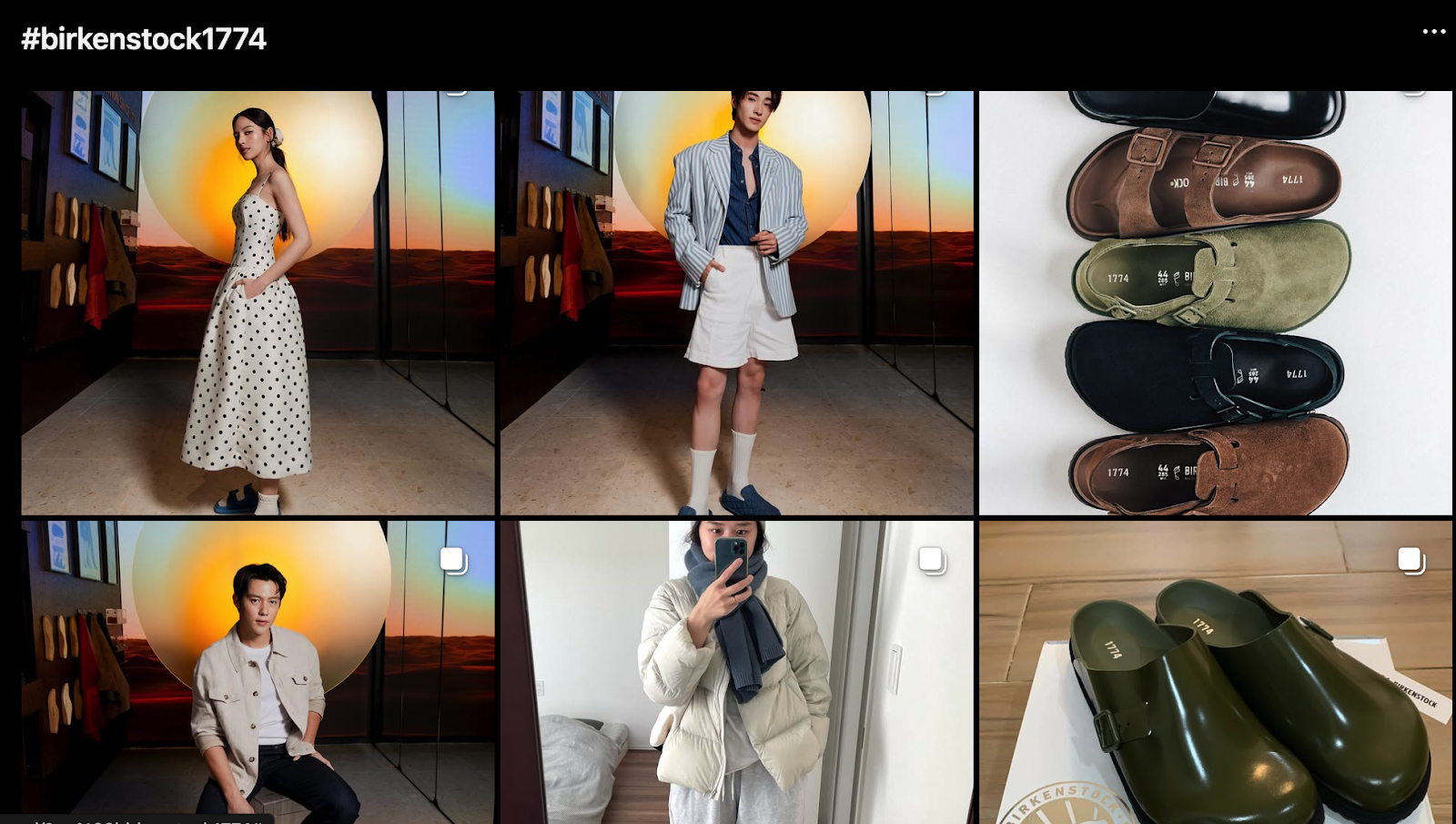
Birkenstock doesn’t stop at service; it works to build a community. With nearly 1.4 million followers on Instagram alone, the brand has created a space for customers to share their stories, style tips, and experiences. Initiatives like #Birkenstock1774 encourages users to show how they wear their products, fostering a sense of belonging while increasing brand visibility.
6. Cultural impact and brand advocacy
Birkenstock has evolved from just a footwear brand to a cultural icon that resonates with many consumers. What began as a practical, orthopedic shoe has transformed into a symbol of effortless, laid-back style—often linked with sustainability, comfort, and authenticity. Its classic design, especially the Arizona sandal, has been embraced by generations of trendsetters, from the counterculture of the 70s to today’s influencers.
| BIRKENSTOCK was one of the first shoe manufacturers in the world to use water-soluble and solvent-free adhesives almost exclusively in its production processes. |
The brand has also built strong advocacy through its community-driven efforts. Birkenstock actively engages with its audience, sparking conversations about environmental responsibility and ethical practices.
This has also helped the brand cultivate a loyal community of conscious consumers who promote its values of comfort, quality, and ecological impact. This advocacy has played a key role in shaping the brand’s narrative and cultural influence.
Key lessons and takeaways from Birkenstock branding strategy
Here are some valuable insights from Birkenstock’s success that can help you strengthen your brand strategy:
1. Embrace tradition with innovation
Birkenstock’s blend of timeless craftsmanship and modern design shows that honoring your heritage while innovating keeps your brand relevant.
2. Prioritize sustainability
Consumers are increasingly eco-conscious. Incorporating sustainable practices, like Birkenstock’s use of cork and latex, can strengthen brand loyalty and attract new customers.
3. Create a strong brand identity
Build a clear, consistent brand identity. Birkenstock’s commitment to quality, comfort, and sustainability has created a distinctive and recognizable brand that resonates with its audience.
4. Leverage strategic partnerships
Collaborations with high-fashion brands and influencers have expanded Birkenstock’s reach. Think about cross-industry partnerships that align with your brand’s values.
5. Use social media creatively
Engage with consumers through authentic, lifestyle-driven content. Birkenstock’s success on platforms like Instagram and Pinterest proves the power of visually appealing, relatable posts.
6. Foster community engagement
Create a sense of belonging by involving your customers. Birkenstock #BirkenstockStyle campaign and in-store consultations strengthen its community.
7. Position your brand in the right market niche
Birkenstock’s strategic positioning between affordable and premium pricing allows it to cater to a wide range of customers, ensuring broad appeal.
8. Build customer trust with storytelling
Use storytelling to emotionally connect with your audience. Birkenstock’s focus on its long history and quality craftsmanship reinforces trust.
9. Invest in e-commerce
A robust digital presence is crucial. Birkenstock’s online store and DTC model investment has led to substantial growth.
10. Focus on customer experience
Providing personalized, responsive service enhances customer satisfaction. Birkenstock’s fitting consultations and user-friendly website show how this builds retention.
Closing thoughts
Birkenstock’s success results from its focus on online sales, global expansion, and innovation. The brand has earned a loyal following by staying true to its core values of comfort, quality, and sustainability.
Birkenstock’s global reach is impressive with a presence in over 90 countries. Its shift from third-party platforms like Amazon to direct online sales has paid off, allowing the brand to connect directly with customers and ensure a better shopping experience.
Birkenstock’s focus on comfort and longevity, even through trendy collaborations, shows its timeless appeal will never go out of style. With strong financial growth and a successful IPO, the future looks bright for Birkenstock as it continues to innovate and expand.
Building a footwear business and need help with branding? Reach out to us today.




